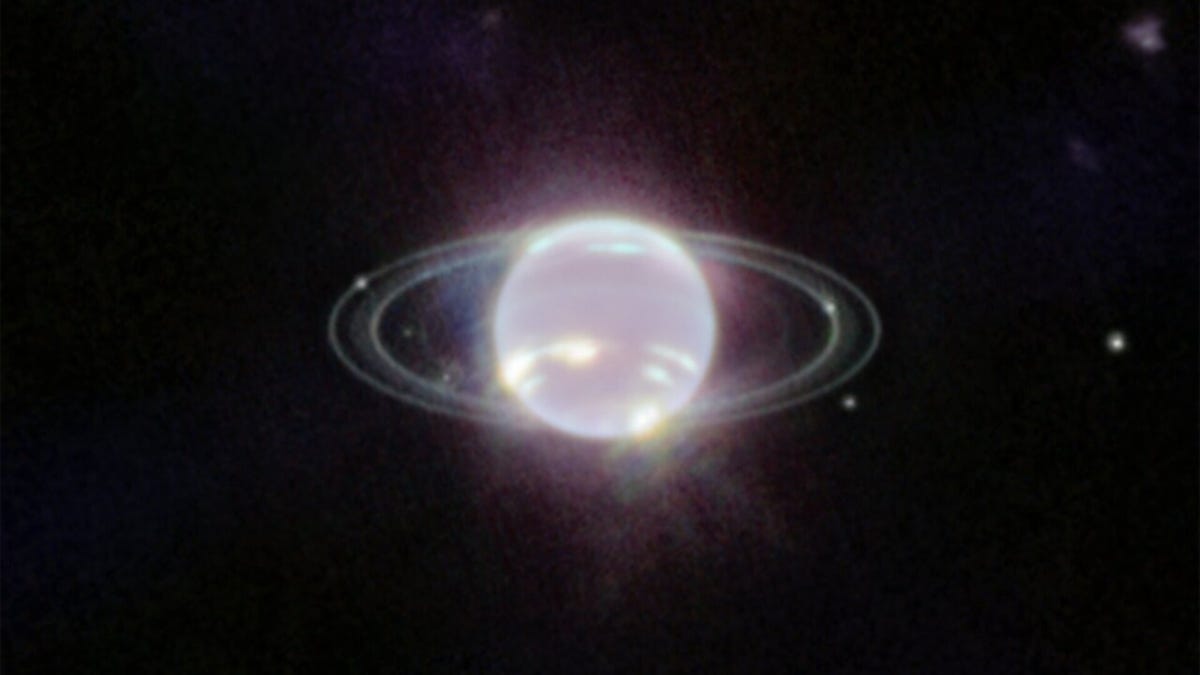Stunning NASA James Webb Telescope Image Reveals Neptune's Delicate Rings
The trailblazing machine delivers once again, offering us the best view of Neptune since 1989.

Neptune is seen with its rings, a rare sight.
When we imagine a world embraced by cosmic haloes, we typically envision Saturn. One might even argue Saturn based its entire personality on those dazzling rings -- and rightfully so. They're solid. Visible. Luxurious even.
But if you didn't already know, it is my honor to tell you Neptune has rings too.
They're just much daintier and therefore superhard to see without superpowered telescopes. The planet itself, in fact, lies 30 times farther from the sun than Earth does and appears to standard stargazing instruments as nothing more than a weak speck of light.
Despite our inability to admire Neptune's fragile hoops from here, scientists caught a wonderful glimpse of them girding the azure realm in 1989 thanks to NASA's traveling probe Voyager -- and on Wednesday, the agency's equally exceptional James Webb Space Telescope presented us with round two.
"It has been three decades since we last saw these faint, dusty rings, and this is the first time we've seen them in the infrared," Heidi Hammel, Neptune system expert and interdisciplinary scientist for the JWST, said in a statement. "Webb's extremely stable and precise image quality permits these very faint rings to be detected so close to Neptune."
And as if that weren't enough, this new image exhibits Neptune, surely emanating a soft lavender glow under the JWST's Near-Infrared lens, against a backdrop of galaxies deftly picked up by the same piece of next-gen space tech. It's unambiguous proof that the JWST is far too sensitive to capture what we might consider "blank space." This machine is powerful enough to serendipitously open a box of treasure every single time it gazes into the void.
Without further ado, Neptune:
In this image by Webb's Near-Infrared Camera (NIRCam), a smattering of hundreds of background galaxies, varying in size and shape, appear alongside the Neptune system. It was officially captured on July 12, 2022.
Of every image taken by the JWST so far, this one is simply my favorite.
Its depth of field gives me existential butterflies because it's disquieting to see a full-on planet, rings included, solely floating in front of deceptively small galaxies that are, in reality, hundreds of thousands of light-years across. These galaxies sit at gigantic distances from our solar system's cosmic neighborhood (home to our very own Neptune), yet carry wads more cosmic neighborhoods.
For comparison, here's what Voyager captured of Neptune's rings in 1989.
Breaking down the JWST's lens on Neptune
The brilliant luminescence we see in the JWST's portrait of Neptune exists only because it's filtered by the telescope's infrared powers. We're looking at a depiction of invisible, infrared wavelengths emanated by the gaseous world.
We aren't looking at the sort of visible wavelengths we're used to -- ones that show us color, like the kind the Hubble Space Telescope works with, for instance. Neptune still has its signature blue tint stemming from elements on the planet, such as methane gas, but the JWST can't show them to us. That's not what it was built to do.
The Hubble Space Telescope shows Neptune in its blue glory while tracking two dark storms on the planet. The larger one is toward the center top and the smaller one is to the right.
"In fact, the methane gas is so strongly absorbing that the planet is quite dark at Webb wavelengths," the European Space Agency said in a press release, "Except where high-altitude clouds are present. Such methane-ice clouds are prominent as bright streaks and spots, which reflect sunlight before it is absorbed by methane gas."
You can further see a thin line of brightness circling the planet's equator, which the team says may indicate global atmospheric circulation attached to Neptune's winds and storms. "The atmosphere descends and warms at the equator, and thus glows at infrared wavelengths more than the surrounding, cooler gasses," NASA said.
At the northern pole, the agency says, there's also an "intriguing brightness," and at the southern pole, further proof of a vortex present on the orb's surface.
Last but definitely not least, of Neptune's 14 known moons, the JWST caught seven: Galatea, Naiad, Thalassa, Despina, Proteus, Larissa and Triton. Exhibiting the JWST's signature six-spiked glare, Triton is seen in its weird backward orbit, offering hope to astronomers that the JWST can help decode the bizarre situation.
The JWST captured seven of Neptune's moons.
"Dominating this Webb portrait of Neptune is a very bright point of light sporting the signature diffraction spikes seen in many of Webb's images," ESA said. "It's not a star, but Neptune's most unusual moon, Triton."
It's the context of the image that really gets me, though. If we zoom out from Triton and those delicately dusted Neptune rings and those polar vortex mysteries, it becomes evident we can see these cosmic details only by sheer coincidence of existing in this iota of the universe.

